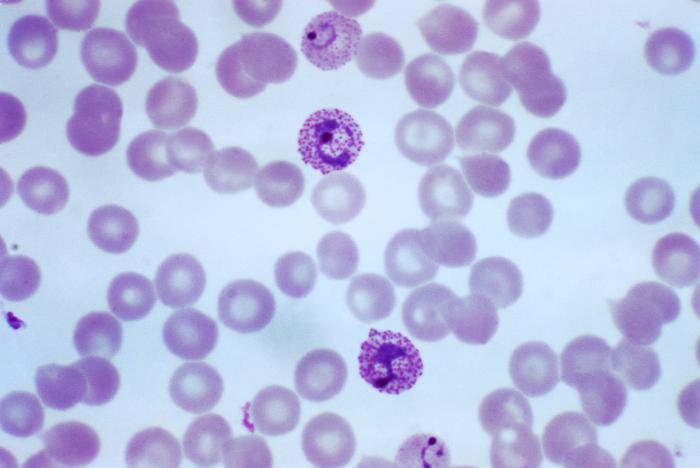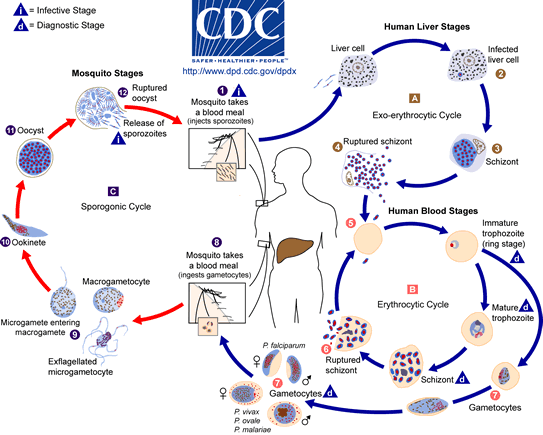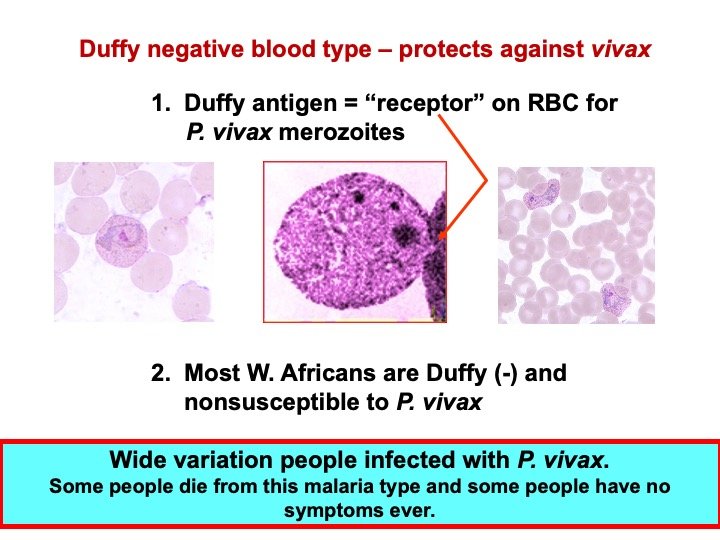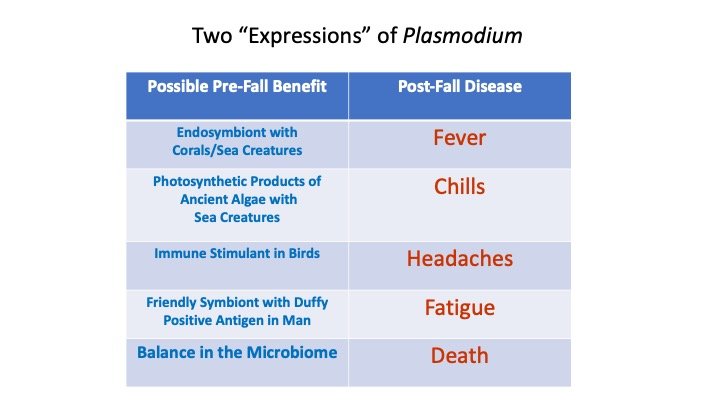
The Return of Malaria to the USA
Did God Create Parasites to Make Us Sick?
Abstract
Summer 2023, the Centers for Disease Control and Prevention reported several cases of locally acquired malaria in Florida, Texas, and Maryland, meaning that patients were infected within the US—the first such cases in over two decades (CDC 2023). The significance of the cases and how individuals and public health officials should respond to the situation is still unknown. The CDC is collaborating with state health departments on an investigation of seven locally acquired cases of Plasmodium vivax malaria in Sarasota County, Florida, and one case in Cameron County, Texas, and Maryland near Washington DC. There is no evidence to suggest that the cases are related. All patients were promptly treated at area hospitals and are recovering (CDC 2023).
How Did It Get Here?

Fig. 1. Anopheles quadrimaculatus. Most common mosquito found in the Southern USA that transmits malaria. ©Edward McCellan, USCDCP, via Wikimedia Commons
“Most malaria cases diagnosed in the United States are imported, usually by persons who travel to countries where malaria is endemic. However, locally acquired mosquito-transmitted malaria cases can occur, as Anopheles mosquito vectors [Fig. 1] exist throughout the United States. In 2003, there were eight cases of locally acquired P. vivax malaria identified in Palm Beach County, Florida” (CDC 2023). Several cases were also reported in Virginia in 2002 and in California in 1986. In each case, the “homegrown” malaria cases were within about 10 miles of an airport. Although not proven, it appears that people infected with malaria (unknowingly) entered the USA infected with malaria and got bit by local mosquitoes, and it spread locally in native Anopheles species. A person can be bit overseas and not have symptoms for two weeks after being infected.
Malaria is caused by Plasmodium parasites (Fig. 2), which are transmitted from one person to another by the bite of a certain group of mosquitoes, the Anophelines (Gillen and Sherwin 2013). While endemic, or continuous, transmission of malaria was eliminated from the US in the 1950s, mosquitoes that can transmit malaria are still present. While CDC and local public health agencies try to control mosquito populations, weather and other factors can complicate and escalate mosquito numbers.

Fig. 2. Photomicrograph of a blood smear with immature and mature trophozoites of Plasmodium vivax. Immature trophozoites of P. vivax have a characteristic ring shape (top), while mature trophozoites contain large ameboid cells. Centers for Disease Control and Prevention (CDC), via Wikimedia Commons
These cases in Florida, Texas, and Maryland are attracting attention because these are rare cases of local transmission within the US. In contrast, the approximately 2,000 annual cases of malaria that are usually reported in the US are in individuals traveling back from malaria-endemic areas, where they were infected. There have been 24 such cases so far this year in Florida, for example. But imported malaria cases are seen in almost every state, suggesting that health professionals need to be vigilant, asking patients about their travel histories to determine whether they have traveled to malaria-endemic areas.
In terms of the locally transmitted cases, by far the most likely scenario is that local mosquitoes bit individuals who were infected in a malaria-endemic country and then traveled back to the US. The locally infected mosquitoes then bit the unsuspecting patients. The individuals with the initial imported infections could have been symptomatic or asymptomatic.
The cases within Florida appear to cluster in one county—seven cases were reported there over the course of a month, and infected mosquitoes have now been found in the area. However, officials do not yet know the exact entry or spread of the disease. Genomic studies of the parasites will help to track their origins.
All the patients were infected with the parasite species Plasmodium vivax. This is the most widespread of the different malaria parasites that infect humans and is very resilient to public health elimination efforts. While it can sometimes cause severe disease, it is rarely fatal. However, Plasmodium vivax presents a challenge in that it can remain dormant in an infected individual’s liver. If the parasites are not initially killed by intensive treatment, they can be reactivated several years later, resulting in new infections. Some authorities believe that Plasmodium vivax is the most widespread species of malaria and may make up 40–45% of total malaria cases in the world. Plasmodium falciparum makes up 50% of the global cases, and the combination of P. vivax with P. falciparum might make up 95% of all cases today. P. vivax is often called benign or mild malaria, but it is known to be more serious than once thought. P. falciparum is called malignant malaria and is responsible for considerable deaths in Africa.
How It Spreads
For successful local (within the USA) malaria transmission, you need several factors simultaneously: an infected person, Anopheles mosquitoes that can transmit Plasmodium, temperatures warm enough for the parasite to develop in the mosquito, and the mosquito to bite an exposed and susceptible human. These specific conditions are very rarely met in the US. If temperatures are too cool (15°C or 59°F) for Plasmodium vivax, development cannot be completed, and malaria cannot be transmitted. The current cases are most likely because tropical travel has accelerated this year, meaning that there are infected individuals to “seed” US transmission. There has been an increase in mosquito populations in the hot and humid areas where the cases occurred. There are also 12 cases of “homegrown” dengue fever in Florida this year. Importantly, the cases highlight the potential for a return of malaria, dengue, and West Nile in the future. Higher than average temperatures, such as we are seeing this year, could significantly increase mosquito populations, and we should be prepared at a public health level (Harvard News 2023).
Plasmodium vivax
Plasmodium vivax looks designed: at least in a strange way. It has a stage in red blood cells (RBCs) that looks very amoeboid. It streams, moves, and “grooves” inside the cell. It is distinct over other Plasmodium with its large amoeba trophozoites and Schuffner dots, as seen under the microscope. Under Giemsa stain, the methylene blue when applied properly gives it a super blue azure look (Fig. 3). It is a beautiful monster under the microscope. It has amazing movement with cytoplasmic streaming in the trophozoite stage. It has movement in its ookinete stage that creeps along the mosquito gut. It has movement that is flagella-like in the exflagellation stage. Sporozoites that start in the mosquito, are injected into the skin and bloodstream after the mosquito bites, swim through the bloodstream, and enter the liver have complex gliding movements. Its movement is intricate, irreducibly complex, interdependent, and its life cycle is incredibly complex, pointing to design. I have a grudging admiration for Plasmodium’s wizardry of adaptation to varying mosquito species, man, and environments.

Fig. 3. P. vivax identification. PowerPoint image via Alan Gillen
Typically, the malaria parasite would be identified from a small blood “prick” sample with thin and thick preparations on the blank microscope slide. On Giemsa-stained blood smears, P. vivax parasites may be present. Because P. vivax invades erythrocytes, infected RBCs will appear larger than uninfected cells. Trophozoite may appear as thick, large ameboid rings, about one-half the diameter of the RBC, and Schuffner’s dots are present. P. vivax schizonts contain 12 to 24 merozoites, almost fill the entire cell, and also contain Schuffner’s dots (Figs. 2 and 3).
Why Would God Design This?
Although we do not know with certainty the pre-fall state of Plasmodium, it may have lived a friendly symbiont with another creature, like coral or animal.
Remember that God created everything “very good” in Genesis 1 and 2. It wasn’t until after Adam sinned (Genesis 3) that death and disease were brought into the universe. Although we do not know with certainty the pre-fall state of Plasmodium, it may have lived a friendly symbiont with another creature, like coral or animal. Its design is not effaced, but the very good function has been erased. Some people in West Africa (Duffy positive) who are infected with it have very little consequence. They live with minimal or no symptoms. However, for those outside West Africa (Duffy negative), they can have mild to severe symptoms and are occasionally killed. The “racial” variation in the distribution of Duffy antigens is a result of a positive selection pressure—the absence of Duffy antigens on RBCs makes the RBCs more resistant to invasion by a malarial parasite.
Globally, Plasmodium falciparum and Plasmodium vivax account for the majority of cases of malaria. While Plasmodium falciparum is responsible for more deaths, Plasmodium vivax is the most widespread of all the malaria species and can cause severe, even fatal infections and results in significant global morbidity and mortality. P. vivax is the most widespread of the malaria species. More than one-third of the world’s population, nearly 2.5 billion people, is at risk of infection with P. vivax malaria. Due to its dormant liver phase, P. vivax can survive in colder climates than other species of malaria, giving it a wider geographical range, including tropics, subtropics, and temperate climates. The highest prevalence is in Latin America and Southeast Asia. It was once a very prominent infection in the USA until the 1950s when it was nearly eradicated. It was also the common malaria of Italy, the Mediterranean Sea, Turkey, and the Middle East during the time of Christ and the early Christians.
Malaria’s Origin Hypothesis
We do not know with certainty the origin of Plasmodium as a parasite or the origin of malaria. The vector of malaria, Anopheles mosquitoes, would have been created on day five and would have had a good role as a pollinator of plants. Plasmodium is too intricate, and its life cycle is too complex (Fig. 4) to have happened by chance. It looks designed, and we know it was created and not evolved. Plasmodium is better seen as a product of degeneration, displacement, and devolution; not upward, onward evolution and endosymbiosis, as portrayed by evolutionists. After the fall of man, these algal-like organisms began to degenerate and became displaced. Like all true parasites, Plasmodium came to rely on a host for shelter and nutrient acquisition. Due to the complexity of the Plasmodium life cycle and its easy adaptation to Anopheles mosquitoes, we hypothesize that, possibly as an algae symbiont, it originally had one life stage in the gut of mosquitoes and another outside the mosquito. The algae photosynthetic product may have supplied protein or material needed for females to make eggs (Gillen and Sherwin 2013).

Fig. 4. Malaria Life Cycle. CDC, via Wikimedia Commons
The other possibility is that it existed with mammals or man already, apart from a coral creature. Even today, some P. vivax strains do not cause any harm whatsoever to individuals who are Duffy positive (Fig. 5). Some West Africans live a lifetime with no symptoms. Plasmodium vivax is also known as the cause of benign tertian malaria. It is an acute febrile illness caused by Plasmodium vivax. P. vivax is the most widespread prevalent plasmodium species and usually has a benign course with no complications or death. There is some mystery in its wide variation: from no symptoms to mild symptoms to severe, malignant symptoms. Some of it is a genetic difference (i.e. Duffy antigen), some of it an immune response difference, some of it is a dose (parasitemia) difference, some of it is mystery (Roberts, Janovy, and Nadler 2013). Plasmodium vivax threatens almost 40% of the world’s population, resulting in 132–391 million clinical infections each year.

Fig. 5. P. vivax and Duffy antigen. PowerPoint image via Alan Gillen
Malaria in the Bible
Malaria, no doubt, played a role in the lives of Jews and early Christians. Although it is not named specifically in the Scriptures, it is possible that two accounts in the Bible are referring to malaria: Deuteronomy 28:22 (fever) and Matthew 8:14–16, paralleled in Mark 1:30–31 and Luke 4:37–38, (the fever in Peter’s mother-in-law). According to medical doctor and apologist A. Rendle Short (1955), the most likely Bible passages pertaining to malaria are those of fever in Peter’s mother in-law.
Paul’s Thorn and Luke’s Record of Journeys
Malaria was also suggested in the 1800s by archaeologist Sir William Ramsay. He was a famous apologist, and even Sir Ronald Ross (the one who discovered the cause of malaria) knew of him.
What happened, Ramsay guessed, is that Paul caught malaria while traveling through the coastal plains of Pamphylia (western Turkey) during his first missionary journey. This coast’s marshes bred malaria-carrying mosquitoes. The tendency for malaria to recur with alternating bouts of sweating and shivering seems to fit well with Paul’s choice of the word torment, which refers to something that continually or often battered him. (Miller 1995)
Life Is in the Blood
Blood signifies life to the medical practitioner. It feeds every cell in the body with its precious nutrients. When it gets infected with the malaria parasite, our body falters. If we know Christ, then, we will be given a new body (perhaps with perfect blood) in heaven. Our bodies may not be perfect this side of heaven; however, we can praise God that our bodies are made fearfully and wonderfully. Science confirms that life is in the blood!

Fig. 6. Two Expressions of Plasmodium. PowerPoint image via Alan Gillen
The malaria parasite has returned to the US, and it will likely come and go again. Plasmodium was intelligently designed, but in a fallen world, it can cause great misery and concern (fig. 6). New and old diseases will come and go: in a fallen world, we can expect it. Not until Christ returns or takes us home to heaven will we have complete healing from the Great Physician.
References
CDC. 2023. “Locally Acquired Cases of Malaria in Florida and Texas.” Malaria News. Last reviewed July 24, 2023. Archived July 29, 2023, at https://web.archive.org/web/20230729224614/https://www.cdc.gov/malaria/new_info/2023/malaria_florida.html.
Gillen, A. L., and Frank Sherwin. 2013. “The Genesis of Malaria. The Origin of Mosquitoes and Their Protistan Cargo, Plasmodium falciparum.” Answers in Genesis. June 19, 2013. https://answersingenesis.org/biology/disease/the-genesis-of-malaria/.
Harvard News. 2023. “Why Are We Seeing New Malaria Cases in the U.S.?” Harvard T.H. Chan School of Public Health. July 12, 2023. https://www.hsph.harvard.edu/news/features/new-malaria-cases-in-the-u-s-manoj-duraisingh/.
Miller, S. 1995. “Bald, Blind & Single?” Christianity Today 47 (July 1, 1995). https://www.christianitytoday.com/history/issues/issue-47/bald-blind-single.html.
Roberts, L. and John Janovy, Jr., and Steve Nadler. 2013. Gerald D. Schmidt and Larry S. Roberts’ Foundations of Parasitology, 9th ed. Boston: WCB McGraw-Hill.
Short, A. 1955. The Bible and Modern Medicine: A Survey of Health and Healing in the Old and New Testaments. London: Paternoster Press.
Bibliography
Bogitsh, B., Clint Carter, and Thomas Oeltmann. 2018. Human Parasitology, 5th ed. London: Academic Press.
Desowitz, R. S. 1991. The Malaria Capers: Tales of Parasites and People. New York: W.W. Norton.
Gillen, A. L. 2023. Parasitology Lab Manual, 3rd ed. Edgewood, MD: Academx.
Sullivan, J. 2017. A Color Atlas for Parasitology, 9th ed. San Francisco: Publishing Company.
Answers in Depth
2023 Volume 18
Answers in Depth explores the biblical worldview in addressing modern scientific research, history, current events, popular media, theology, and much more.
Browse VolumeRecommended Resources

Answers in Genesis is an apologetics ministry, dedicated to helping Christians defend their faith and proclaim the good news of Jesus Christ.
- Customer Service 800.778.3390
- Available Monday–Friday | 9 AM–5 PM ET
- © 2025 Answers in Genesis



